 Backend Development
Backend Development
 PHP Tutorial
PHP Tutorial
 Example introduction: Use Docker to quickly build a multi-version PHP development environment
Example introduction: Use Docker to quickly build a multi-version PHP development environment
Example introduction: Use Docker to quickly build a multi-version PHP development environment
This article brings you relevant knowledge about PHP, which mainly introduces the relevant content on how to use docker to quickly build a multi-version PHP development environment. Let’s take a look at it together and hope it will be helpful to everyone. helpful.
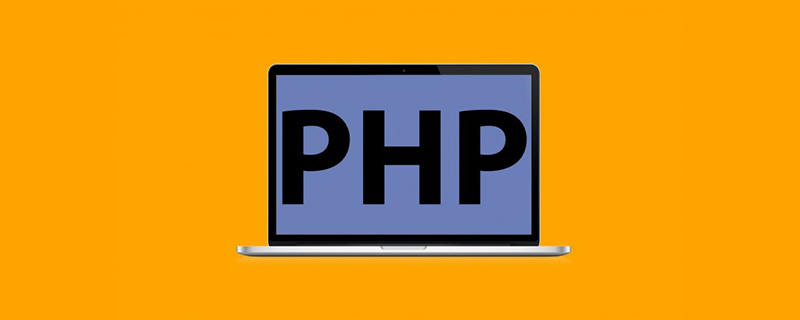
PHP Video Tutorial"
Software used in the article:- Mac: 11.4 (macOS Big Sur), processor: Intel Core.
- Docker: 3.3.3
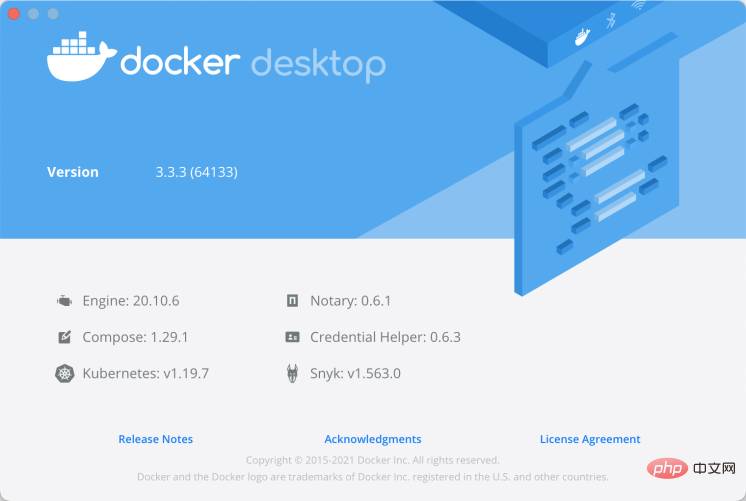 ## Target
## Target
Support PHP 5.6.x Environment
Supports PHP 7.2.x Environment
Download
Docker software download and installation, without too much explanation, just install it step by step.
Download address: Docker official website https://www.docker.com/products/docker-desktop
Agent settings
"registry-mirrors" : [
"http://registry.docker-cn.com",
"http://hub-mirror.c.163.com"
],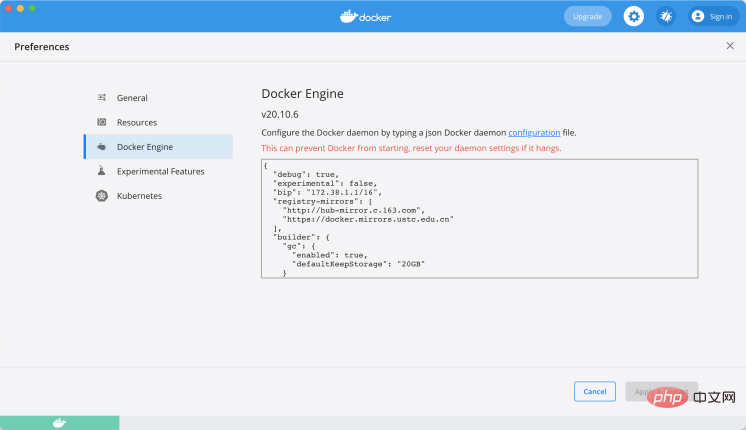 Configure environment
Configure environment
- Start docker;
- Download the compressed package: php7-2-x.zip and decompress it;
- Enter the php7-2-x directory and run docker-compose up directly;
- Browser input: http://127.0.0.1:8081/;
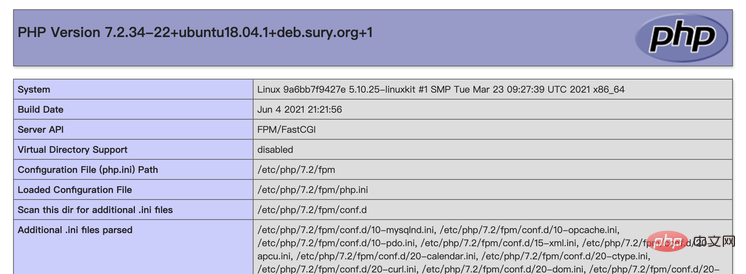 ##PHP 5.6.x , occupying local port 8082
##PHP 5.6.x , occupying local port 8082
Start docker;
- Download the compressed package: php5-6-x.zip and decompress it;
- Enter the php5-6-x directory and run docker-compose up directly;
- Browser input: http:// 127.0.0.1:8082/;
Port mapping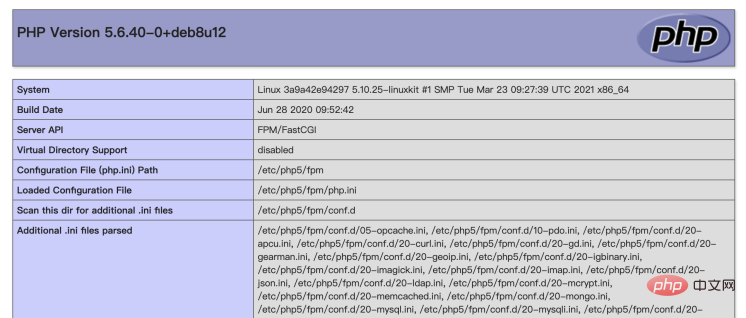
Download method:
Download from the Chrome App Store and search for Simple Proxy.
- Load the local extension, download address: chrome-simply-proxy[2]
- Look at the installed interface:
After successful configuration, visit http://local.php72.com/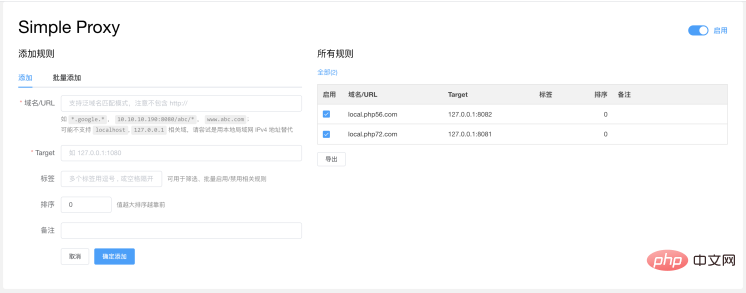
##local.php56.com - > 127.0.0.1:8082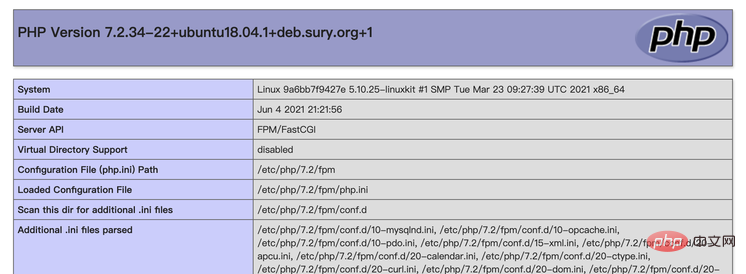
Same as above. Remarks
docker-compose related commandsdocker-compose up Build container parameters [-d] for background operation
docker-compose start Enable container
docker-compose stop Stop container
docker- compose restart Restart the container
docker-compose down Delete the container
- ##docker-compose ps View the current container status
php7-2-x Directory Introduction
├── docker-compose.yml
├── log
│ └── nginx
│ └── local.php72.com_access.log
├── phpdocker
│ ├── README.html
│ ├── README.md
│ ├── nginx
│ │ └── default.conf
│ └── php-fpm
│ ├── Dockerfile
│ └── php-ini-overrides.ini
└── web
└── phpinfo
└── index.phpversion: "3.1"
services:
webserver:
image: nginx:alpine
container_name: php7-2-x-webserver
working_dir: /application
volumes:
- .:/application
- ./phpdocker/nginx:/etc/nginx/conf.d
ports:
- "8081:80"
php-fpm:
build: phpdocker/php-fpm
container_name: php7-2-x-php-fpm
working_dir: /application
volumes:
- .:/application
- ./phpdocker/php-fpm/php-ini-overrides.ini:/etc/php/7.2/fpm/conf.d/99-overrides.iniserver {
listen 80;
server_name local.php72.com;
client_max_body_size 108M;
access_log /application/log/nginx/${server_name}_access.log;
root /application/web/phpinfo;
index index.php;
# try to serve file directly, fallback to index.php
location / {
try_files $uri /index.php$is_args$args;
}
if (!-e $request_filename) {
rewrite ^.*$ /index.php last;
}
location ~ \.php$ {
fastcgi_pass php-fpm:9000;
fastcgi_index index.php;
fastcgi_param SCRIPT_FILENAME $document_root$fastcgi_script_name;
fastcgi_param PHP_VALUE "error_log=/application/log/nginx/${server_name}_php_errors.log";
fastcgi_buffers 16 16k;
fastcgi_buffer_size 32k;
include fastcgi_params;
}
}- Add the file local.abc.com.conf and point the code directory to the abc directory in the configuration file;
- Restart the container docker-compose restart;
- php5-6-x directory introductionSame as above.
How to generate zip file?
You may have questions, how is the zip file generated? What if I want to build another version of the environment?These files are generated online, URL: https://phpdocker.io/generator[3]
Supported PHP versions are: 5.6. x, 7.0.x, 7.1.x, 7.2.x, 7.3.x, 7.4.x, etc.
It also supports MySQL, MariaDB, Elasticsearch, etc. 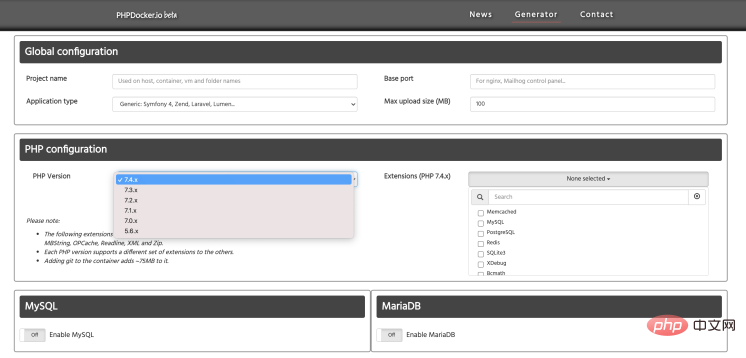
After selecting as needed, click Generate project archive to generate the compressed package.
The above php5-6-x.zip and php7-2-x.zip are generated in this way. They are just fine-tuned, such as configuring the log directory, web directory, etc.
Recommended learning: "PHP Video Tutorial"
The above is the detailed content of Example introduction: Use Docker to quickly build a multi-version PHP development environment. For more information, please follow other related articles on the PHP Chinese website!

Hot AI Tools

Undresser.AI Undress
AI-powered app for creating realistic nude photos

AI Clothes Remover
Online AI tool for removing clothes from photos.

Undress AI Tool
Undress images for free

Clothoff.io
AI clothes remover

AI Hentai Generator
Generate AI Hentai for free.

Hot Article

Hot Tools

Notepad++7.3.1
Easy-to-use and free code editor

SublimeText3 Chinese version
Chinese version, very easy to use

Zend Studio 13.0.1
Powerful PHP integrated development environment

Dreamweaver CS6
Visual web development tools

SublimeText3 Mac version
God-level code editing software (SublimeText3)

Hot Topics
 1378
1378
 52
52
 PHP 8.4 Installation and Upgrade guide for Ubuntu and Debian
Dec 24, 2024 pm 04:42 PM
PHP 8.4 Installation and Upgrade guide for Ubuntu and Debian
Dec 24, 2024 pm 04:42 PM
PHP 8.4 brings several new features, security improvements, and performance improvements with healthy amounts of feature deprecations and removals. This guide explains how to install PHP 8.4 or upgrade to PHP 8.4 on Ubuntu, Debian, or their derivati
 How To Set Up Visual Studio Code (VS Code) for PHP Development
Dec 20, 2024 am 11:31 AM
How To Set Up Visual Studio Code (VS Code) for PHP Development
Dec 20, 2024 am 11:31 AM
Visual Studio Code, also known as VS Code, is a free source code editor — or integrated development environment (IDE) — available for all major operating systems. With a large collection of extensions for many programming languages, VS Code can be c
 7 PHP Functions I Regret I Didn't Know Before
Nov 13, 2024 am 09:42 AM
7 PHP Functions I Regret I Didn't Know Before
Nov 13, 2024 am 09:42 AM
If you are an experienced PHP developer, you might have the feeling that you’ve been there and done that already.You have developed a significant number of applications, debugged millions of lines of code, and tweaked a bunch of scripts to achieve op
 How do you parse and process HTML/XML in PHP?
Feb 07, 2025 am 11:57 AM
How do you parse and process HTML/XML in PHP?
Feb 07, 2025 am 11:57 AM
This tutorial demonstrates how to efficiently process XML documents using PHP. XML (eXtensible Markup Language) is a versatile text-based markup language designed for both human readability and machine parsing. It's commonly used for data storage an
 Explain JSON Web Tokens (JWT) and their use case in PHP APIs.
Apr 05, 2025 am 12:04 AM
Explain JSON Web Tokens (JWT) and their use case in PHP APIs.
Apr 05, 2025 am 12:04 AM
JWT is an open standard based on JSON, used to securely transmit information between parties, mainly for identity authentication and information exchange. 1. JWT consists of three parts: Header, Payload and Signature. 2. The working principle of JWT includes three steps: generating JWT, verifying JWT and parsing Payload. 3. When using JWT for authentication in PHP, JWT can be generated and verified, and user role and permission information can be included in advanced usage. 4. Common errors include signature verification failure, token expiration, and payload oversized. Debugging skills include using debugging tools and logging. 5. Performance optimization and best practices include using appropriate signature algorithms, setting validity periods reasonably,
 PHP Program to Count Vowels in a String
Feb 07, 2025 pm 12:12 PM
PHP Program to Count Vowels in a String
Feb 07, 2025 pm 12:12 PM
A string is a sequence of characters, including letters, numbers, and symbols. This tutorial will learn how to calculate the number of vowels in a given string in PHP using different methods. The vowels in English are a, e, i, o, u, and they can be uppercase or lowercase. What is a vowel? Vowels are alphabetic characters that represent a specific pronunciation. There are five vowels in English, including uppercase and lowercase: a, e, i, o, u Example 1 Input: String = "Tutorialspoint" Output: 6 explain The vowels in the string "Tutorialspoint" are u, o, i, a, o, i. There are 6 yuan in total
 Explain late static binding in PHP (static::).
Apr 03, 2025 am 12:04 AM
Explain late static binding in PHP (static::).
Apr 03, 2025 am 12:04 AM
Static binding (static::) implements late static binding (LSB) in PHP, allowing calling classes to be referenced in static contexts rather than defining classes. 1) The parsing process is performed at runtime, 2) Look up the call class in the inheritance relationship, 3) It may bring performance overhead.
 What are PHP magic methods (__construct, __destruct, __call, __get, __set, etc.) and provide use cases?
Apr 03, 2025 am 12:03 AM
What are PHP magic methods (__construct, __destruct, __call, __get, __set, etc.) and provide use cases?
Apr 03, 2025 am 12:03 AM
What are the magic methods of PHP? PHP's magic methods include: 1.\_\_construct, used to initialize objects; 2.\_\_destruct, used to clean up resources; 3.\_\_call, handle non-existent method calls; 4.\_\_get, implement dynamic attribute access; 5.\_\_set, implement dynamic attribute settings. These methods are automatically called in certain situations, improving code flexibility and efficiency.



